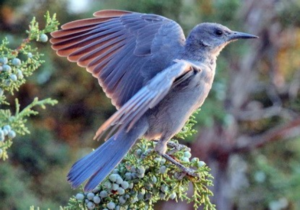Pinyon jay decline has roots in pinyon-juniper removal
By Lael Gilbert, SageSTEP Outreach Coordinator
Restoration of sagebrush ecosystems through removal of pinyon-juniper woodlands is in full swing across much of the Intermountain West—reclaiming sagebrush where pinyon juniper expansion has occurred due to lack of fire and more precipitation during past climatic cycles. This practice has measurable benefits including restoration of habitats and connectivity for Greater sage-grouse and other sagebrush obligate species. But in the larger complex ecological system across the Great Basin, there can inevitably be unintended consequences for any management action. One potential consequence in the balance is the Pinyon Jay (Gymnorhinus cyanocephalus). This bird’s population declined by a startling 85% between 1970 and 2014, according to Partners in Flight. The group estimates that if the current rate of decline continues, Pinyon Jays will lose another half of their remaining population by 2036. Pinyon Jays occur across a large expanse of the west including the Great Basin primarily in the southern and eastern half.
 Pinyon Jays present both a conservation challenge and a paradox. While the species has declined, its preferred habitat (pinyon-juniper woodlands) has expanded, and in some areas to a large extent. It seems that population declines are not a function of reductions in habitat amount, but are related to changes in habitat quality. Up to now research on the species has been paltry, and so details about the trend have only recently begun to surface.
Pinyon Jays present both a conservation challenge and a paradox. While the species has declined, its preferred habitat (pinyon-juniper woodlands) has expanded, and in some areas to a large extent. It seems that population declines are not a function of reductions in habitat amount, but are related to changes in habitat quality. Up to now research on the species has been paltry, and so details about the trend have only recently begun to surface.
“Factors that are driving the Pinyon Jay population decline are still a bit of mystery,” said Patrick Magee, jay researcher at Western State Colorado University. But it seems that the species’ decline involves changes in the age and structure of pinyon-juniper woodlands, he said. Pinyon jays prefer a mixed-age mosaic of woodland interspersed with sagebrush shrubland. Although they roost and nest within relatively dense groves of older trees, they typically locate their nests usually within half a mile of the habitat edge. The large expanses of homogenous closed-canopy pinyon-juniper woodland that have become more common over the past century are largely unsuitable for the birds.
To further cement their complex fate, Pinyon Jays depend on caching pinyon pine nuts. The jays make heavy use of pine nut crops early to late fall, and mainly rely on these seed caches along with other food sources over the rest of the year. Seed caches are usually located in the woodland-shrubland transition zone, or in pure shrublands within 3 miles of the woodland edge.
This caching strategy and preferred nesting sites ties these birds to a complex, “shaggy” edge of a pinyon juniper woodland. This structure typical of mixed-age woodlands with shrub openings and a complex habitat edge are what Pinyon Jays prefer and what continues to decrease.
Management activities within pinyon-juniper woodlands over the last six decades have primarily focused on tree removal to increase forage for wildlife and livestock, and more recently on fuel reduction and GRSG habitat objectives. Mastication and thinning strategies, to this point, have had an adverse impact on the pinyon-juniper/sagebrush transition zone that Pinyon Jays and many other species need. While these treatments are widely accepted as cost-effective means of meeting short-term management goals, a considerable amount of uncertainty remains about the long-term impacts on species composition for pinyon-juniper obligate species like the Pinyon Jay.
Land managers have an opportunity to make pinyon-juniper treatments compatible with the habitat requirements for a multitude of species such as Pinyon Jays. For example, treatments are planned on a project-by-project scale, so the overall picture of impact on Pinyon Jay populations may be missed. A move to landscape-scale priority planning for tree-removal treatments could help align proposed projects with pinyon-juniper stands where Pinyon Jays will not be impacted. Treatments can incorporate elements that benefit Pinyon Jays such as: avoid creating sharp habitat edges between reclaimed sagebrush and closed-canopy woodland; incorporate a mixed-edge or convoluted edge treatment strategy; retain a mosaic of large areas of open and mixed-age woodland habitat; retain cone-bearing trees; and avoid disturbance within 0.6 miles from known nesting sites and colonies. These elements will also benefit many other species that depend on this transition zone (e.g. mule deer) and mature pinyon-juniper woodlands.
If removal of pinyon-juniper woodlands remains a priority for land managers, we need to develop management strategies that benefit a multitude of species occurring in the Great Basin and help mitigate impacts on the Pinyon Jay before it becomes a crucial “sage grouse-like” issue. With the amount of treatment planned in the near future by land managers, it could become a major problem.
“Birds respond to pinyon-juniper thinning treatments in complex ways. You can’t generalize how the bird community will react to a particular treatment,” said Magee. “Each species behaves in its own way and even within a species the response could be complex. Pinyon Jays may benefit if woodland thinning is done in a way that creates more foraging habitat, but simultaneously they may decline when the same thinning reduces nesting cover. Management needs to move into more nuanced approaches, there’s no one-size fits all restoration treatment for the whole pinyon-juniper bird community.”
But if PJ removal is detrimental for the pinyon jay, it may still be better than allowing woody fuels to build up and result in large wildfires, making large areas unsuitable for jays. Mechanical tree removal projects could be designed to reduce woody fuels and leave selected habitat areas for the pinyon jays.
“Pinyon-juniper thinning treatments represent a challenging land management balancing act between competing ecological values, especially at the interface of sagebrush and pinyon-juniper ecosystems, and social and economic values. Avian species conservation requires innovative and nuanced approaches that encapsulate the complexity of the system,” Magee said.
References:
Ammon, E. M., and J. D. Boone (2014). Long-term declines in Pinyon Jays as a function of landscape changes. Presentation at the Western Field Ornithologists’ Conference, Great Basin Observatory, San Diego, CA, USA.
Balda, R. P. 2002. Pinyon Jay (Gymnorhinus cyanocephalus). In The Birds of North America, No. 605 (A. Poole and F. Gill, eds.). The Birds of North America, Inc., Philadelphia, PA.
Coop, J.D., and P.A. Magee. Integrating Fuels Treatments and Ecological Values in Piñon-Juniper Woodlands: Fuels, Vegetation, and Avifauna. Final Report to the Joint Fire Science Program. 2016. Agreement number L13ACOO23.
Great Basin Bird Observatory. http://www.gbbodata.org/pdf/bcp/63_Pinyon%20Jay.pdf
Johnson, K., T. B. Neville, J. W. Smith, and M. W. Horner. 2016. Home range- and colony-scale habitat models for Pinyon Jays in piñon-juniper woodlands of New Mexico, USA. Avian Conservation and Ecology 11(2):6. http://dx.doi.org/10.5751/ACE-00890-110206
Partners in Flight. 2016. http://pif.birdconservancy.org/ACAD/Database.aspx
Rosenberg, K.V.; J. A. Kennedy, R. Dettmers, R. P. Ford, D. Reynolds, J.D. Alexander, C. J. Beardmore, P. J. Blancher, R. E. Bogart, G. S. Butcher, A. F. Camfield, A. Couturier, D. W. Demarest, W. E. Easton, J.J. Giocomo, R.H. Keller, A. E. Mini, A. O. Panjabi, D. N. Pashley, T. D. Rich, J. M. Ruth, H. Stabins, J. Stanton, T. Will. 2016. Partners in Flight Landbird Conservation Plan: 2016 Revision for Canada and Continental United States. Partners in Flight Science Committee. 119 pp. 2016. http://www.partnersinflight.org/wp-content/uploads/2016/08/pif-continental-plan-final-spread-single.pdf
Sauer, J. R., J. E. Hines, J. E. Fallon, K. L. Pardieck, D. J. Ziolkowski, Jr., and W. A. Link (2014). The North American Breeding Bird Survey, Results and Analysis 1966 – 2013. Version 01.30.2015. USGS Patuxent Wildlife Research Center, Laurel, MD, USA.
Contact
Lisa Ellsworth
Project Co-coordinator
Dpt. Fisheries & Wildlife
Oregon State University
Corvallis, OR 97330
Email
(541) 737-0008
Beth Newingham
Project Co-coordinator
GB Rangelands Research
USDA Ag. Res. Service
Reno, NV 89512
Email
(775) 784-6057 ext. 233
Lael Gilbert
Outreach Coordinator
Utah State University
5215 Old Main Hill
Logan, Utah 84322-5215
Email
(435) 797-8455

Site Designed by Kite Media